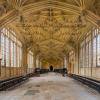II.3 'Universitas magistrorum et scholarium’: a self-governing corporation of teachers and students
Commentary
What did it mean to be a self-governing corporation of masters? A vivid impression is preserved in Oxford University's Convocation House, which sits below Selden End of the Bodleian Library and School's Quadrangle complex.
‘Convocation’ is Oxford's ‘universitas magistrorum’ in its broadest sense: it comprised all masters (both regent and non-regent) of the University (that is to say, all holders of masters degrees recognized by the colleges of Oxford, irrespective of whether they are currently teaching in the University). Before 1508, this body exercised the supreme legislative authority of the University, and this authority was reinstated by Title X of the Laudian Statutes of 1636.
The following year, Convocation House was completed, providing a purpose-built venue for the meetings of Convocation within the Schools Quadrangle and Bodleian Library complex. The essential configuration of the room resembles that of the image of Paris a century earlier: the chancellor sits in a magnificent throne at the end of a long room, with benches on either side for the members of the academic community. In this case, the benches wrapping around the far end of the room are interrupted by a doorway leading the Chancellor’s Court, in which the chancellor or his representative presided over legal cases involving the university community. More information on Convocation House and its predecessor, Congregation House, is available here and here.
Commentary. Howard Hotson (May 2018).

